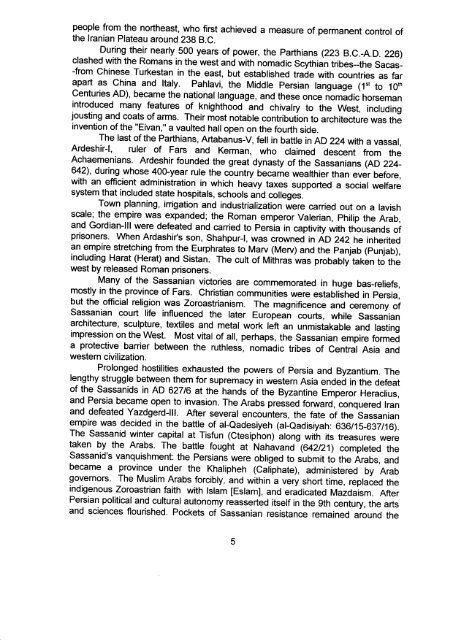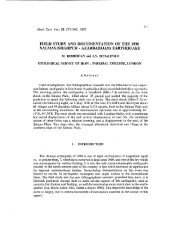PDF COPY - Manuel berberian
PDF COPY - Manuel berberian
PDF COPY - Manuel berberian
Create successful ePaper yourself
Turn your PDF publications into a flip-book with our unique Google optimized e-Paper software.
people from the northeast, who first achieved a measure of permanent control ofthe lranian Plateau around 239 B.C.During their nearly 500 years of power, the parthians (223 B.C._A.D. 226)clashed with the Romans in the west and with nomadic Scythian-fromtribes-the Sacas-Chinese Turkestan in the east, but established trade with countries as farapart as China and ltaly. Pahlavi, the Middle Persian language (1"t to 1OhCenturies AD), became the national language, -and and these once nomadic horsemanintroduced many features of knighthood chivalry to the West, includingjousting and coats of arms. Their most notable contribution to architecture was theinvention of the "Eivan," a vaurted hall open on the fourth side.The last of the Parthians, Artabanus-V, fell in batfle in AD 224 with a vassal,Ardeshir-|, ruler of Fars and Kerman, who claimed descent from theAchaemenians. Ardeshir founded the great dynasty of the Sassanian s (AD 224-642), during whose 400-yearule the country became wealthier than ever before,with an efficient administrationwhich heavy taxes supported a social welfaresystem that included state hospitals, schools and colleges.Town planning, irrigation and industrialization were carried out on a lavishscale; the empire was expanded; the Roman emperor Valerian, philip the Arab,and Gordian-lll were defeated and carried to Persia in captivity with thousands ofprisoners. \l/hen Ardashir'son, Shahpur-|, was crowned in AD 242 he inheritedan empire stretching from the Eurphrates to Marv (Merv) and the panjab (punjab),including Harat (Herat) and Sistan. The cult of Miihras was probablytaken to thewest by released Roman prisoners.Many of the Sassanian victories are commemorated in huge bas-reliefs,mostly in the province of Fars. Christian communities were established in persia,but the official religion was Zoroastrianism. The magnificence and ceremony ofSassanian court life influenced the later European courts, while Sassanianarchitecture, sculpture, textiles and metal work left an unmistakable and lastingimpression on the West. Most vital of all, perhaps, the Sassanian empire formeda protective barrier between the ruthless, nomadic tribes of Central Asia andwestern civilization.Prolonged hostilities exhausted the powers of Persia and Byzantium. Thelengthy struggle between them for supremacy in western Asia ended in the defeatof the Sassanids in AD 627t6 at the hands of the Byzantine Emperor Heraclius,and Persia became open to invasion. The Arabs pressed forward, conquered lranand defeated Yazdgerd-lll. After several encounters, the fate of the Sassanianempire was decided in the battle of al-Qadesiyeh (al-eadisiyah: 636/15-637/16).The Sassanid winter capital at Tisfun (Ctesiphon) along with its treasures weretaken by the Arabs. The battle fought at Nahavand (642121) completed theSassanid's vanquishment the Persians were obliged to submito the Arabs, andbecame a province under the Khalipheh (Caliphate), administered by Arabgovernors' The Muslim Arabs forcibly, and within a very short time, replaced theindigenous Zoroastrian faith with lslam [Eslam], and eradicated Mazdaism. AfterPersian political and cultural autonomy reasserted itself in the gth century, the artsand sciences flourished. Pockets of Sassanian resistance remained around the







